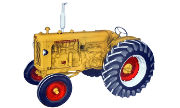
Minneapolis-Moline GTB Technical Specifications
Minneapolis-Moline GTB is a Row-Crop tractor that was produced by the John Deere between 1947 – 1954.
Below you will find detailed technical specifications for Minneapolis-Moline GTB covering engine types, horsepower ratings, weight, height, fuel type and tank volume, oil capacity and type, hydraulic system diagram, wiring diagram, battery specs, etc.
Minneapolis-Moline GTB Production
| Manufacturer: | |
| Manufacturer: | Minneapolis-Moline |
| Type: | Standard-tread tractor |
| Factory: | Minneapolis, Minnesota, USA |
| Original price: | $2400 (1954 ) |
| Engine: | |
| Drawbar (claimed): | 37 hp 27.6 kW |
| PTO (claimed): | 54 hp 40.3 kW |
| Drawbar (tested): | 49.53 hp 36.9 kW |
| Belt (tested): | 58.03 hp 43.3 kW |
Minneapolis-Moline GTB Mechanical
| Chassis: | 4×2 2WD | ||||||||||||||||||||||||||||||||||||||||||||||||||||||||||||||||||||||||||||||||||||||||||||||||||||||||||||
| Steering: | manual | ||||||||||||||||||||||||||||||||||||||||||||||||||||||||||||||||||||||||||||||||||||||||||||||||||||||||||||
| Brakes: | mechanical band | ||||||||||||||||||||||||||||||||||||||||||||||||||||||||||||||||||||||||||||||||||||||||||||||||||||||||||||
| Cab: | Open operator station. | ||||||||||||||||||||||||||||||||||||||||||||||||||||||||||||||||||||||||||||||||||||||||||||||||||||||||||||
| Transmission: | 5-speed gear | ||||||||||||||||||||||||||||||||||||||||||||||||||||||||||||||||||||||||||||||||||||||||||||||||||||||||||||
Power Take-off (PTO)
Title serial numbers
What year is my Minneapolis-Moline GTB? Serial Number DecoderThe serial number list shows the first tractor built in each year. The other tractors for that year will have successively higher numbers. Your serial number should be between two of the stated numbers. The list only includes the numbers of the first tractors produced in each year. Your serial should be somewhere between two numbers.Unless you happen to be the first person to own a tractor, your number will not appear on the list. Minneapolis-Moline GTB Engine detail
Minneapolis-Moline GTB Dimensions
Minneapolis-Moline GTB TestsNebraska Tractor Test 437 |
FAQIs Minneapolis-Moline GTB a good tractor? The Minneapolis-Moline GTB is one of the great tractors in the Minneapolis-Moline stable, and it has earned Minneapolis-Moline a fantastic reputation. How much oil does a Minneapolis-Moline GTB take? Check out the Minneapolis-Moline GTB oil capacity and oil type in the engine specs section as it may vary across the engines. Keep in mind, that older models might have their oil capacity increased over time. You may compare between the early and late oil capacity. Do tractors have VIN numbers? Every tractor has a VIN number. The number is usually engraved below the driver’s seat. Tractor manufacturers put the number in different places on the tractor body. What was the last year Minneapolis-Moline made the GTB? The Minneapolis-Moline GTB was an agricultural tractor model made from 1947 – 1954 Where is the serial number on a Minneapolis-Moline GTB? Lookup right side of tractor frame, just ahead of operator platform. | ||||||||||||||||||||||||||||||||||||||||||||||||||||||||||||||||||||||||||||||||||||||||||||||||||||||||||||
